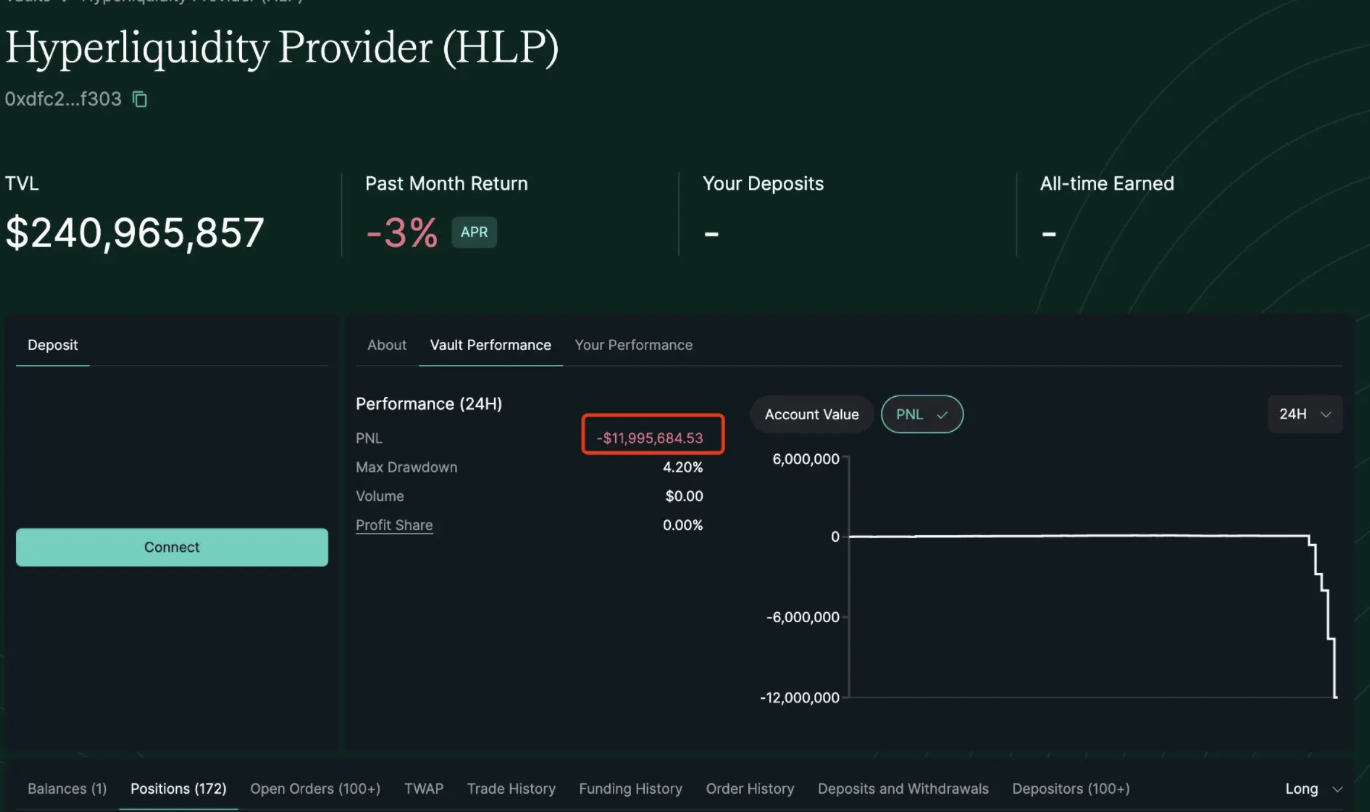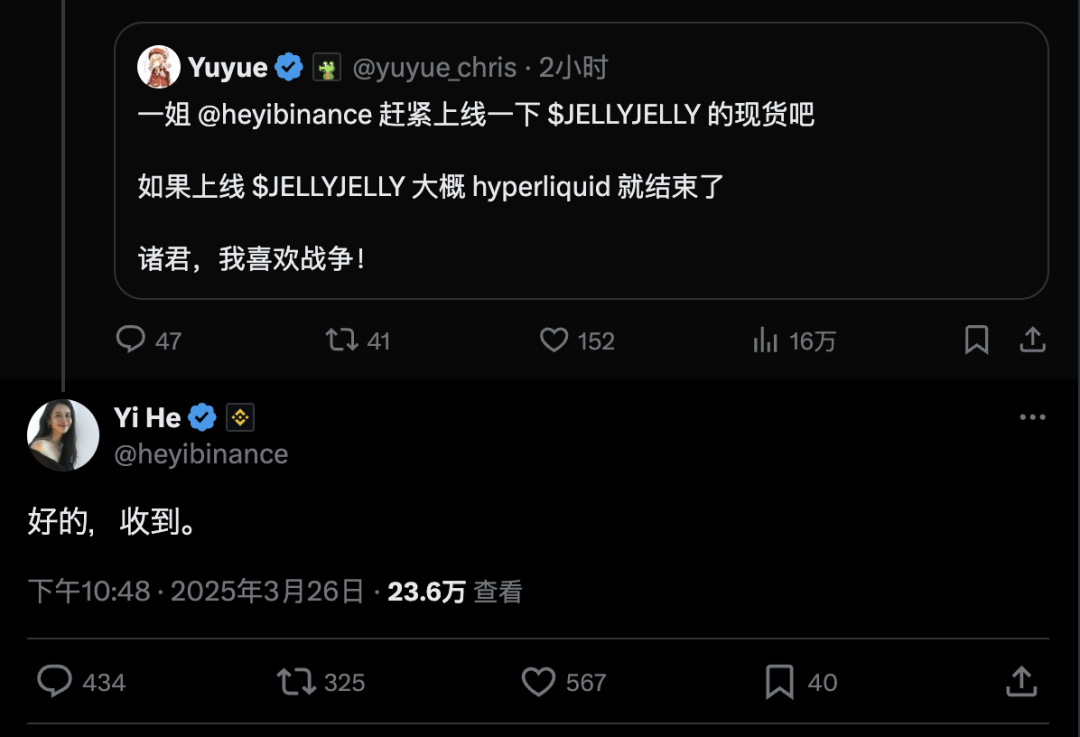The crypto market in 2025 is different than before. As market funds are increasingly concentrated in the hands of a few whales, the risk of manipulation is increasing. Just in March, Hyperliquid, a derivatives protocol known as "Binance on the chain", was once again caught up in a whale manipulation scandal, this time the protagonist was the popular Solana chain memecoin JELLYJELLY.
This storm not only caused huge losses to Hyperliquid's HLP vault, but also caused drastic fluctuations in the platform token HYPE. As market concerns continue to heat up, people can't help but question whether this once-popular on-chain derivatives trading platform can survive this crisis.

A Whale's Careful Layout
The story begins with an inconspicuous on-chain wallet address: "0xde96". This user took a fancy to JELLYJELLY, a memecoin on the Solana chain jointly created by Venmo co-founder Iqram Magdon-Ismail and investor Sam Lessin. On the surface, it seems to be just an ordinary on-chain transaction.
However, things soon began to develop in an unexpected direction. Another whale trader sold JELLYJELLY on a decentralized exchange, quickly dumping the market and causing the token price to plummet. This drastic price fluctuation caused the "0xde96" address, which opened a short position on the Hyperliquid platform, to be forcibly taken over, and it was Hyperliquid's automatic market-making robot HLP that took over.
In a short period of time, HLP suffered an unrealized loss of up to $12 million after taking over. But the incident is far from over. A brand new wallet address "0x20e8" then suddenly entered the market and bought a large amount of JELLYJELLY at a very low price, which caused the book loss of the HLP vault on Hyperliquid to be further magnified to about $13.5 million.

Hyperliquid’s Tough Decision
Seeing that the situation was about to get out of control, Hyperliquid took quick action. They urgently stopped the perpetual contract trading of JELLYJELLY and froze the relevant contracts, claiming that after discovering "suspicious evidence of market manipulation", the relevant violators were removed from the market after a vote by the validators.
Hyperliquid officials immediately issued a statement, promising: "Except for the marked addresses, all damaged users will receive full compensation from the Hyper Foundation, and the compensation process will be automatically completed based on the on-chain data."
But this statement did not calm the market's uneasiness. On the contrary, more questioning and angry voices appeared on social media. Some industry insiders questioned whether Hyperliquid's move was truly legal and compliant, especially when Hyperliquid directly set the settlement price of JELLYJELLY at $0.0095, instead of the $0.50 given by DEX at the time. This forced liquidation method was fiercely criticized.

Centralized exchanges take advantage of the situation
While Hyperliquid was busy putting out the fire, more powerful players in the market, Binance and OKX, quickly entered the game and launched JELLYJELLY perpetual futures trading within just one hour. The intervention of centralized exchanges has injected huge liquidity and trading volume into the market, causing spot prices to rise rapidly.
In particular, Binance, after announcing the launch of JELLYJELLY contracts, instantly triggered a 560% surge in the spot market. This wave of operations was seen by some analysts as a strategic move by traditional exchanges to squeeze out decentralized competitor Hyperliquid.
For Hyperliquid, this is undoubtedly worse. With the intervention of centralized exchanges, the market share of on-chain protocols has been directly threatened. The market began to worry whether Hyperliquid, once known as "Binance on the chain", could survive this round of turmoil.

How long can Hyperliquid last?
What's more noteworthy is that this is not the first time Hyperliquid has been caught up in the whale manipulation storm. Earlier this month, another whale opened a large Ethereum long position worth more than $300 million on Hyperliquid and quickly left with a profit, causing the market to question Hyperliquid's risk control capabilities.
This time, the whale manipulated JELLYJELLY, directly causing HLP to suffer huge losses, and Hyperliquid's credibility dropped to a historical low. Industry insiders have questioned whether Hyperliquid is really capable of dealing with the risk of whale manipulation? Are there major flaws in its automated market-making mechanism?
Corey Hoffstein, CEO of Newfound Research, publicly questioned Hyperliquid's approach. He believes that this arbitrary setting of liquidation prices is obviously lacking in transparency and may seriously undermine the principle of market fairness.
Some social media users have bluntly stated that if similar manipulation incidents occur again, Hyperliquid's HLP vault may face the risk of a complete collapse, which may trigger a chain reaction and make the protocol unsustainable.
Hyperliquid is frequently "hunted": where is the loophole in the mechanism?
Hyperliquid originally used its own high-performance L1 chain, order book DEX and shared capital pool (HLP) as innovative selling points. However, it encountered whale manipulation incidents in a short month and frequently became a hunting ground for large investors to arbitrage.
First, its hybrid capital pool design buried systemic risks. Although the HLP pool is efficient, all trading pairs share liquidity. Once a small-cap currency such as JELLY is manipulated by a whale to soar or plummet, the capital pool has to take over the huge losses, which will affect the whole body. Bitget CEO Gracy pointed out that this "big pot" pool design opens the door to market manipulation. No wonder whales regard it as an ATM.
Secondly, Hyperliquid's high leverage and lack of position limits further amplify the risk. The platform allows leverage of more than 50 times but has no effective position limit mechanism, which allows large investors to easily build risk positions of millions or even hundreds of millions of dollars in low liquidity markets. Andre Cronje once pointed out that "leverage should not be fixed, but should be adjusted dynamically with liquidity", but Hyperliquid did not follow up on this risk control detail, but instead handed the control of risk to the attacker.
Furthermore, Hyperliquid's liquidation mechanism is too fragile and passive. In this incident, the automatic liquidation mechanism failed to effectively alleviate the liquidity tension, but instead triggered a chain of forced liquidations, and ultimately had to manually intervene to "unplug the network cable". Compared with the circuit breaker mechanism or automatic position reduction (ADL) introduced by mature platforms such as Binance or dYdX, Hyperliquid lacks an effective secondary market buffer mechanism, making it helpless in the face of extreme market conditions.
Finally, the decentralized governance mechanism advertised by Hyperliquid also exposed major contradictions. During this crisis, the platform temporarily voted to freeze the contract and manually marked the illegal accounts. Although it protected user funds in the short term, it sacrificed the so-called decentralization ideal and left a long-term trust risk. The community's concerns about Hyperliquid's centralized operations may further weaken its long-term competitiveness. Therefore, Hyperliquid urgently needs to conduct a deep review of mechanism design and risk control parameters, otherwise similar "hunting" incidents may occur repeatedly.
The future of Hyperliquid
In the face of this crisis, Hyperliquid officially promised to "make the protocol stronger through technical improvements and lessons learned", but whether this can restore market confidence remains unknown.
It is foreseeable that this storm will greatly affect Hyperliquid's future development path. As a representative of decentralized exchanges, its biggest selling point should be openness, transparency and fair trading, but the forced removal of JELLYJELLY contracts may make the market doubt its decentralized nature.
More importantly, whether Hyperliquid can truly strengthen its risk control and prevention mechanisms in the future to prevent similar incidents from happening again may be the decisive factor in its long-term survival.
Conclusion
The impact of Hyperliquid's whale manipulation incident is still fermenting, and the market's doubts have not yet completely subsided.
In an era full of violent fluctuations and whale manipulation risks in the crypto industry, Hyperliquid's situation represents the general dilemma faced by decentralized financial platforms: How to effectively resist the risk of market manipulation while ensuring the principle of decentralization? This is not only a life-and-death test for Hyperliquid, but also a compulsory course for the entire on-chain trading market in the future.
















No comments yet